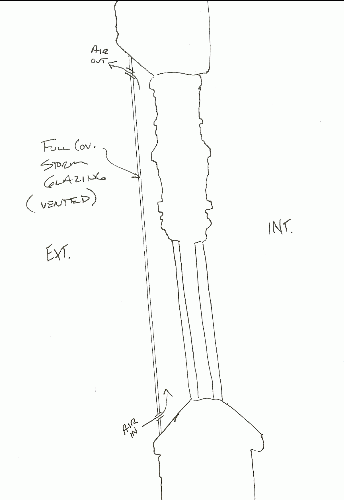Question
The picture below is a wall/window section, interior on the right, exterior on the left. The window is a stained glass unit for which I need to reproduce parts (for lots of windows), and in the case of four windows, reproduce the entire frames. When completed, all of the windows, the repaired and the new, will be completely covered with new storm glazing which will be inside the sill, but well away from the wood frame. I'm not entirely sure how the venting will be done (by others), but the windows will be vented (see drawing). Windows are all well above the ground, and face in all directions.
I am not responsible for the painting of the replacement parts on the largely sound windows or the complete frames. However, everything will be finished appropriately. Given the storm glazing, the painted wood will not be subject to impact moisture, but obviously will to humidity, temperature fluctuation, and sunshine. And while the storm glazing will be removable, I think it's a safe bet that a regular painting/upkeep schedule will not be adhered to.
What are your thoughts on the species for both the replacement parts and the new window frames? I had been planning on poplar, given its cost-effectiveness and readily-available supply, but 90+ percent of my career work has been for interior applications. Recent research tells me poplar is not going to be a good choice for exterior (albeit protected) work. Do I need to look further for, say, Douglas fir?
Just to be clear, I'm not looking to get by on the cheap - this job needs to be lasting - but cost is a definite consideration.

Forum Responses
(Architectural Woodworking Forum)
From contributor J:
I would suggest you look into white oak. Not the cheapest date, however very weather resistant, tough, easy to machine. Knowing maintenance won't be high on the customer's list, it will surely last a long time and no phone calls.
I am pretty sure the existing 120 year-old wood is fir. I have a capital in the shop now, and after stripping, I'm fairly certain of it. So fir was a reasonable replacement wood I thought (after my blunder planning with poplar). I have used cypress for a couple outdoor projects, and no surprise, it's held up beautifully without any treatment or paint, and cedar has weathered likewise. I was concerned about these being too soft, though, and then I also need to think about how available it is locally. I do have a bit of time if I need to have something shipped in, but then I'm back to the budget.
Speaking on the four new complete frames, now, what are the thoughts on using one of the exterior species listed for the outside face, and using poplar for the inside? The window faces are mirror images - all the same ornamental work on the inside as the out. I'm not sure why there would be any problem, but want to make sure I'm not overlooking something. Further, I'm not entirely sure how the windows go together (they'll be pulled sometime next month, I'm told). Might end up with a split-jamb type of deal.
I got a quote today, and asked for the highest price (that is, lowest quantity pricing): $2.68 for 4/4. She told me she has good stock, too, and that she sells a lot of it to another customer doing historical restoration on shutters, balustrade, and the like. I'm planning on going that route. Just need to write up the change order, though I'm not sure the architect even specified species.
The method the glass studio uses for installing their panels in a case like this is small cut nails or tacks for pointing, and silicone for glazing the panel into the wood frame. I plan to allow 1/8" on all sides, provided this corresponds closely enough with the existing. That is, my new frames have to fit the opening the old ones come out of, and the stained glass panels will change in size only fractionally. Actually, they should get smaller since they'll be disassembled, cleaned (new glass where broken pieces are encountered) and then put together again from scratch with new lead. I would presume they'll be nice and tight, no sag, etc.
Is 1/8" on all sides of the glass reasonable if I am using poplar for all parts, interior and exterior? Or does that matter since the glass studio tacks in points all around? I believe the silicone will provide enough flex for humidity-induced movement in the wood, but will the points be a potential culprit in potentially freezing the panel? I'll talk to the glass studio, too.